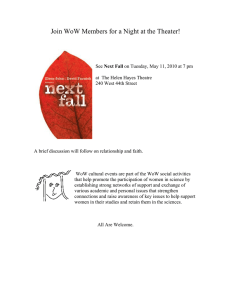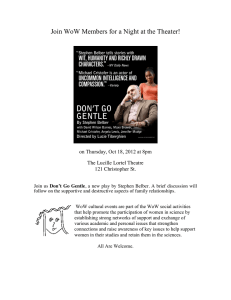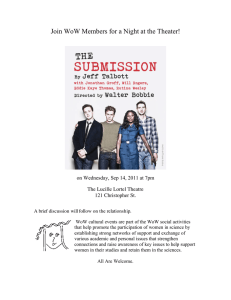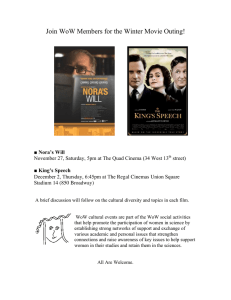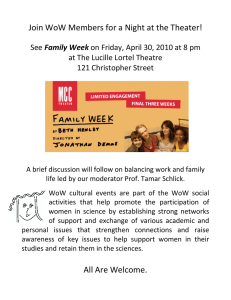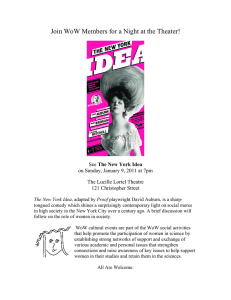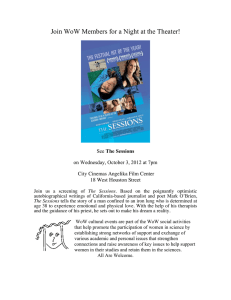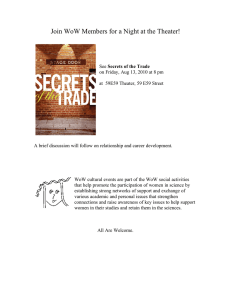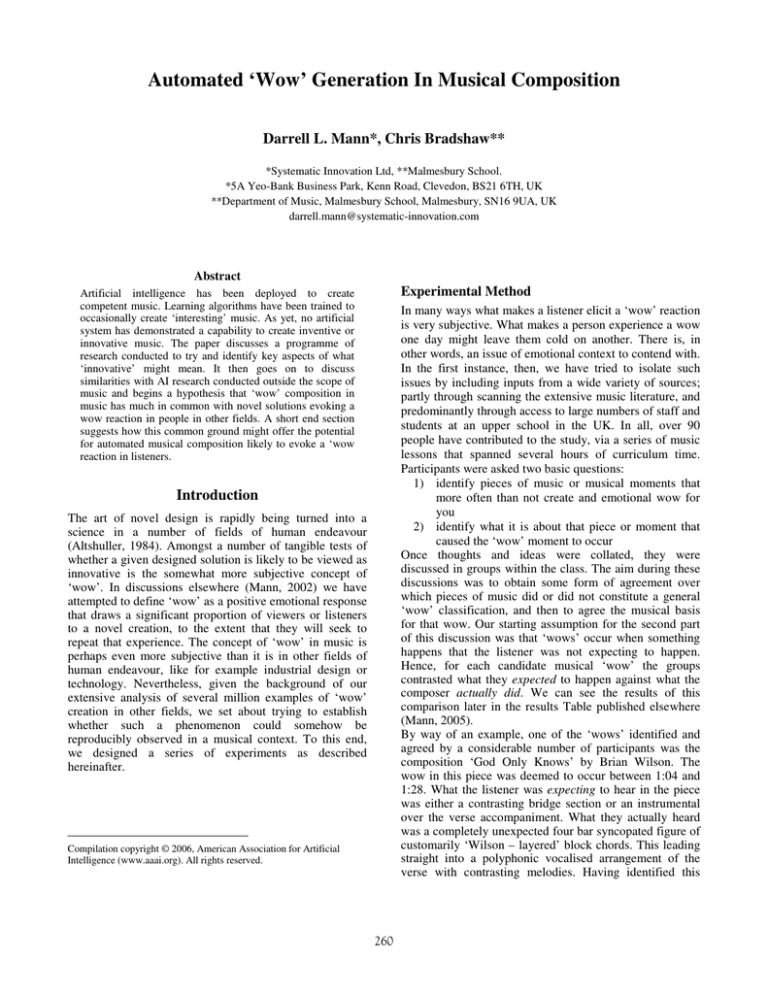
Automated ‘Wow’ Generation In Musical Composition
Darrell L. Mann*, Chris Bradshaw**
*Systematic Innovation Ltd, **Malmesbury School.
*5A Yeo-Bank Business Park, Kenn Road, Clevedon, BS21 6TH, UK
**Department of Music, Malmesbury School, Malmesbury, SN16 9UA, UK
darrell.mann@systematic-innovation.com
Abstract
Experimental Method
Artificial intelligence has been deployed to create
competent music. Learning algorithms have been trained to
occasionally create ‘interesting’ music. As yet, no artificial
system has demonstrated a capability to create inventive or
innovative music. The paper discusses a programme of
research conducted to try and identify key aspects of what
‘innovative’ might mean. It then goes on to discuss
similarities with AI research conducted outside the scope of
music and begins a hypothesis that ‘wow’ composition in
music has much in common with novel solutions evoking a
wow reaction in people in other fields. A short end section
suggests how this common ground might offer the potential
for automated musical composition likely to evoke a ‘wow
reaction in listeners.
In many ways what makes a listener elicit a ‘wow’ reaction
is very subjective. What makes a person experience a wow
one day might leave them cold on another. There is, in
other words, an issue of emotional context to contend with.
In the first instance, then, we have tried to isolate such
issues by including inputs from a wide variety of sources;
partly through scanning the extensive music literature, and
predominantly through access to large numbers of staff and
students at an upper school in the UK. In all, over 90
people have contributed to the study, via a series of music
lessons that spanned several hours of curriculum time.
Participants were asked two basic questions:
1) identify pieces of music or musical moments that
more often than not create and emotional wow for
you
2) identify what it is about that piece or moment that
caused the ‘wow’ moment to occur
Once thoughts and ideas were collated, they were
discussed in groups within the class. The aim during these
discussions was to obtain some form of agreement over
which pieces of music did or did not constitute a general
‘wow’ classification, and then to agree the musical basis
for that wow. Our starting assumption for the second part
of this discussion was that ‘wows’ occur when something
happens that the listener was not expecting to happen.
Hence, for each candidate musical ‘wow’ the groups
contrasted what they expected to happen against what the
composer actually did. We can see the results of this
comparison later in the results Table published elsewhere
(Mann, 2005).
By way of an example, one of the ‘wows’ identified and
agreed by a considerable number of participants was the
composition ‘God Only Knows’ by Brian Wilson. The
wow in this piece was deemed to occur between 1:04 and
1:28. What the listener was expecting to hear in the piece
was either a contrasting bridge section or an instrumental
over the verse accompaniment. What they actually heard
was a completely unexpected four bar syncopated figure of
customarily ‘Wilson – layered’ block chords. This leading
straight into a polyphonic vocalised arrangement of the
verse with contrasting melodies. Having identified this
Introduction
The art of novel design is rapidly being turned into a
science in a number of fields of human endeavour
(Altshuller, 1984). Amongst a number of tangible tests of
whether a given designed solution is likely to be viewed as
innovative is the somewhat more subjective concept of
‘wow’. In discussions elsewhere (Mann, 2002) we have
attempted to define ‘wow’ as a positive emotional response
that draws a significant proportion of viewers or listeners
to a novel creation, to the extent that they will seek to
repeat that experience. The concept of ‘wow’ in music is
perhaps even more subjective than it is in other fields of
human endeavour, like for example industrial design or
technology. Nevertheless, given the background of our
extensive analysis of several million examples of ‘wow’
creation in other fields, we set about trying to establish
whether such a phenomenon could somehow be
reproducibly observed in a musical context. To this end,
we designed a series of experiments as described
hereinafter.
Compilation copyright © 2006, American Association for Artificial
Intelligence (www.aaai.org). All rights reserved.
260
‘wow’ moment, the authors then set about trying to
establish whether this inventive leap fitted into the
framework of leaps observed across other fields of creation
outside of music.
frequency, then, musical wows in our sample were most
likely to be realised through Inventive Strategies:
19 – Periodic Action Shift
17 – ‘Another Dimension’
5 – ‘Merging’
35 – ‘Parameter Change’
13 – ‘The Other Way Around’
One aspect that seems to emerge from a helicopterperspective view of the whole set of results is that there
appear to be three basic categories of ‘wow’:
1) wows associated with a particular moment within a
piece of music
2) wows associated with the overall structure of the piece
of music, and
3) wows associated with high-level shifts around a given
genre of music
What we have in these three categories is a sub-system,
system and super-system view of the world. Thus, if we
take a given individual piece of music and call it ‘the
system’, then we can see wows associated with conflict
resolutions at the system level. We can then zoom in and
see wows within a piece of music (‘sub-system’) and wows
that operate at a higher, ‘super-system level – where the
conflict exists between a piece of music and its prevailing
surroundings.
Systematic Innovation
At this point it is necessary to reflect on the findings of the
extensive prior research conducted in other areas of
innovation. Starting in 1946, around 2000 person-years of
research has been conducted on patents, the sciences,
social, political, marketing and other foci of human
innovation. To date around three million successful
innovations have been analysed. As illustrated in Figure 1,
these analyses have revealed a considerable level of ‘reinventing the wheel’; several million apparently unique
innovations actually collapsing down to what is so far just
40 core ‘inventive strategies’ (Domb, 2005). This is not to
say that there may not be more than 40 such strategies, but
simply that whatever areas have been studied to date, these
40 and only these 40 are observed.
MILLIONS of systems
HUNDREDS of different problems
Implications
In other fields of endeavour, the 40 inventive Strategies are
already beginning to be used to design automated ‘creative
leap’ algorithms (Mann, 2005a for example). From our
initial findings here, we have seen no reasons why the
same 40 Strategies, whether applied at the super-system,
system or sub-system levels could not be integrated into an
automated musical composition algorithm. This is an
activity we plan to accomplish in the next phase of the
research. We are actively looking for partners to participate
in this future activity.
TENS of successful solutions
Figure 1: Key Systematic Innovation Research Finding
The essence of these 40 strategies is that they represent the
only known ways of eliminating a conflict. In turn, it has
been demonstrated that the elimination of a conflict (i.e.
the viewer expects one thing, and then something else
happens) lies at the core of ‘wow’.
References
Altshuller, G.S., 1984. Creativity As An Exact Science.
New York: Gordon & Breach.
Domb, E., 2005. TRIZ Journal, 40 Inventive Principles
With Examples. www.triz-journal.com.
Systematic Innovation
Perhaps the first thing that becomes apparent from the
results of the study is that in 100% of the cases analysed
(close to 50 cases), the results demonstrated that the ‘wow’
was very definitely connectable back to one or more of the
40 known strategies. In the Brian Wilson ‘God Only
Knows’ piece, for example, the use of syncopation and
segmentation, relate respectively to Inventive Strategies 31
and 1. More specifically, then, we might begin to notice
that not all of the 40 Principles are present in the list of
examples. In fact there is quite a strong skew towards a
relatively small subset of the 40. In descending order of
Mann, D.L., 2002, Design For Wow. TRIZ Journal, Oct 2002.
Mann, D.L., Bradshaw, C., 2005. Design For Wow 2 – Music.
TRIZ Journal, Oct 2005.
Mann, D.L., 2005a, Systematic Creativity Algorithms: New
Paradigm Opportunities For Artificial Intelligence. Paper
presented at First Computer-Aided Innovation conference, Ulm,
Germany, November 2005.
Compilation copyright © 2006, American Association for Artificial
Intelligence (www.aaai.org). All rights reserved.
261

